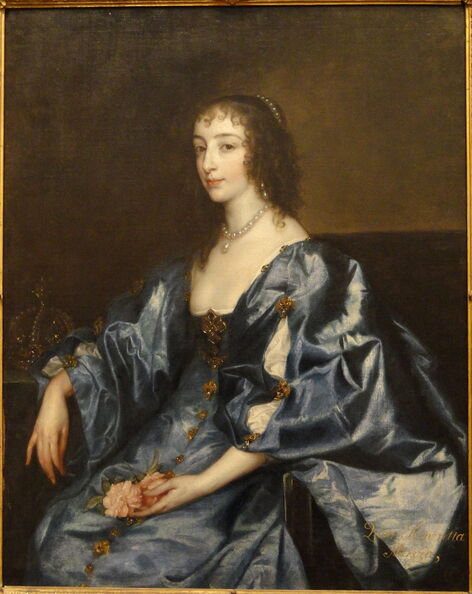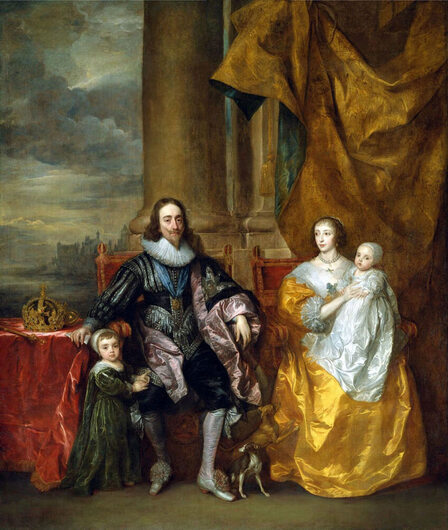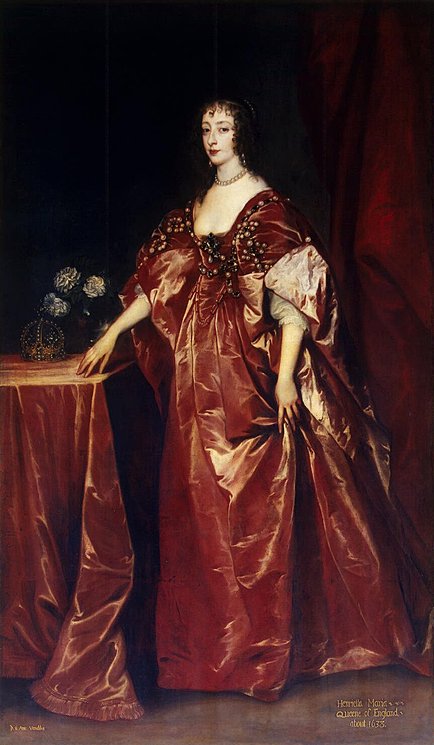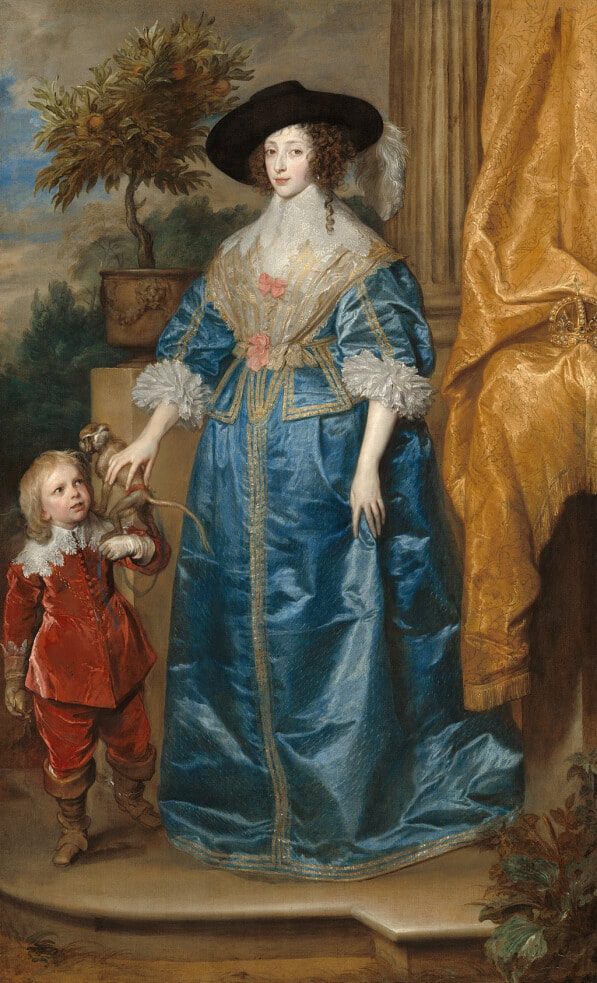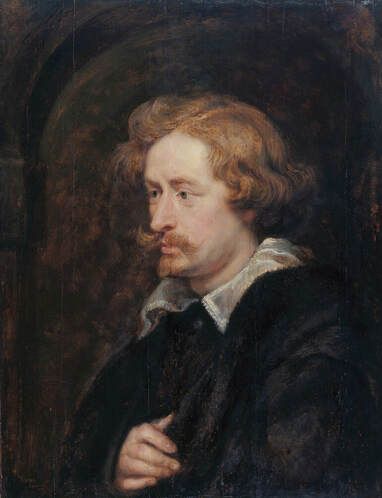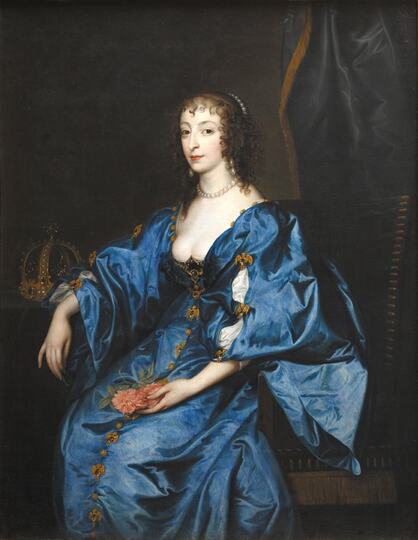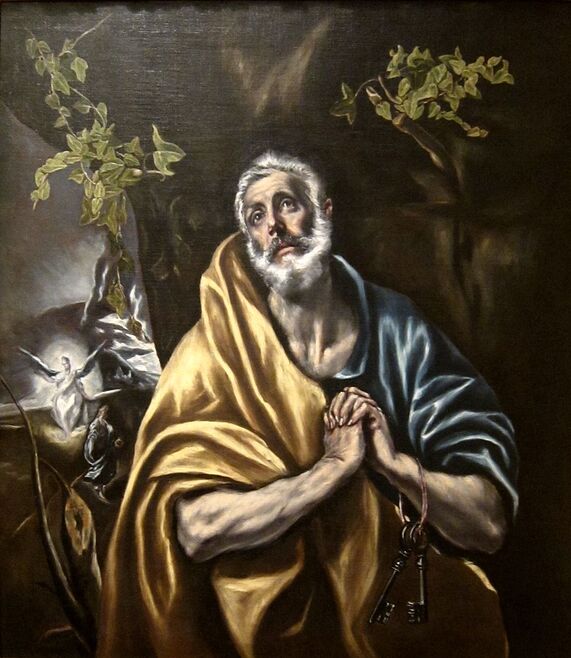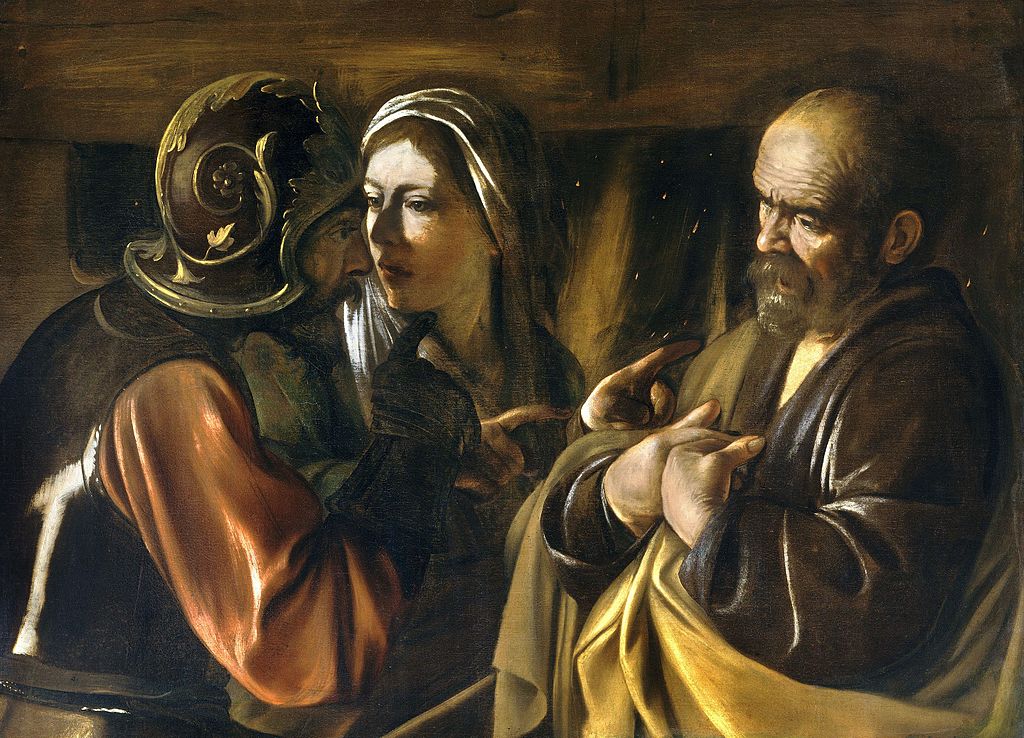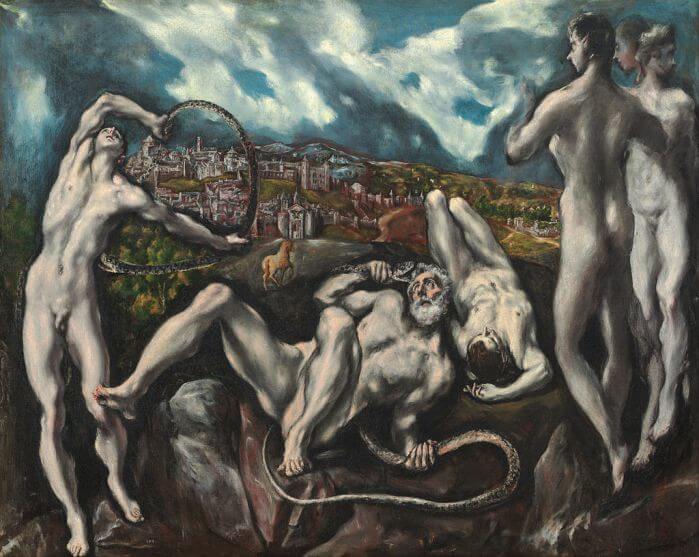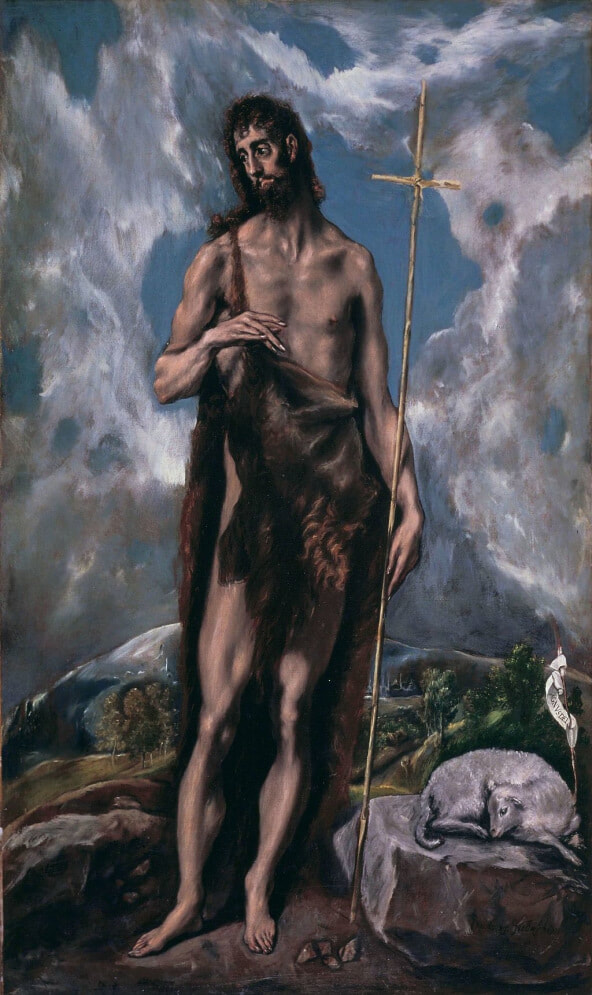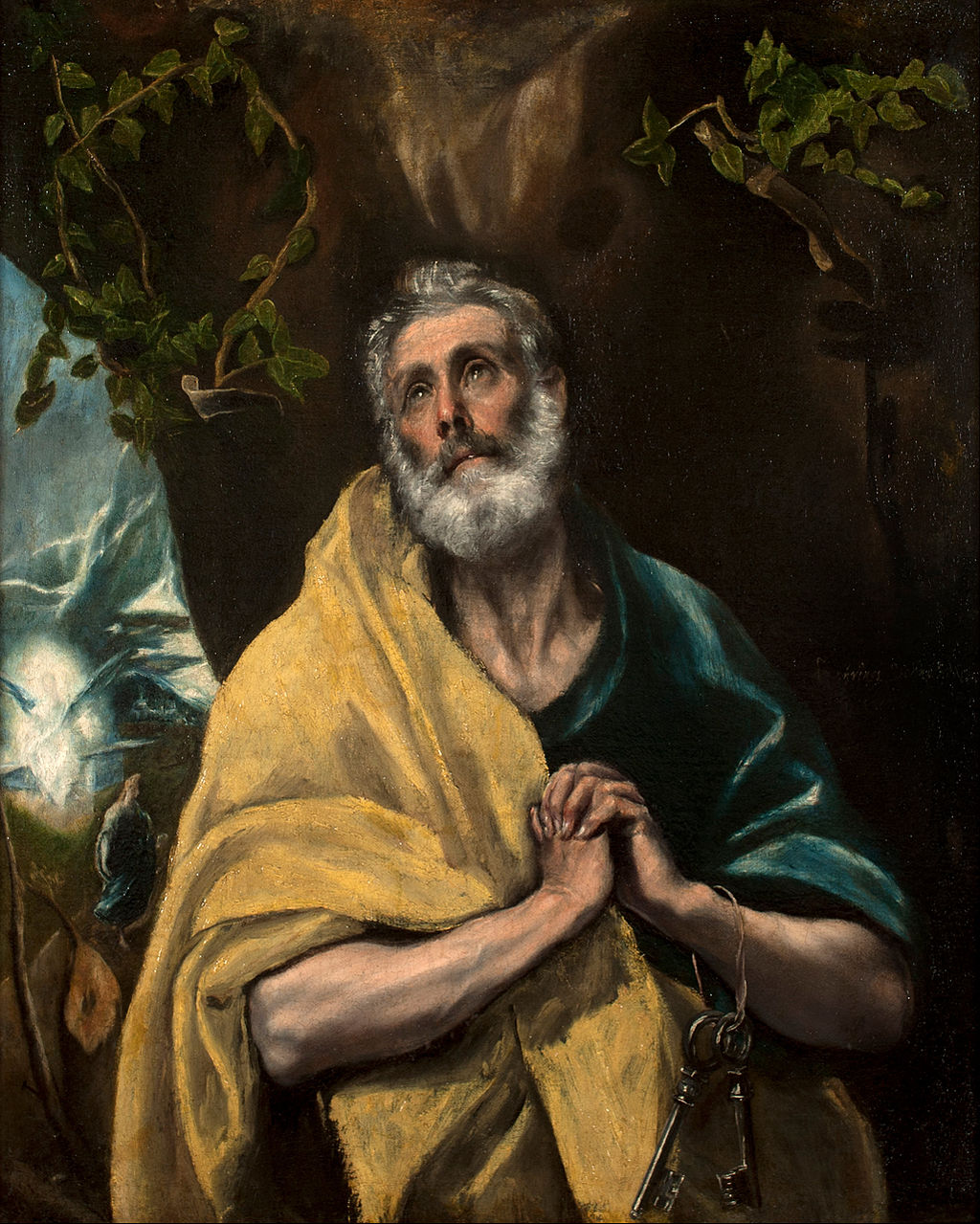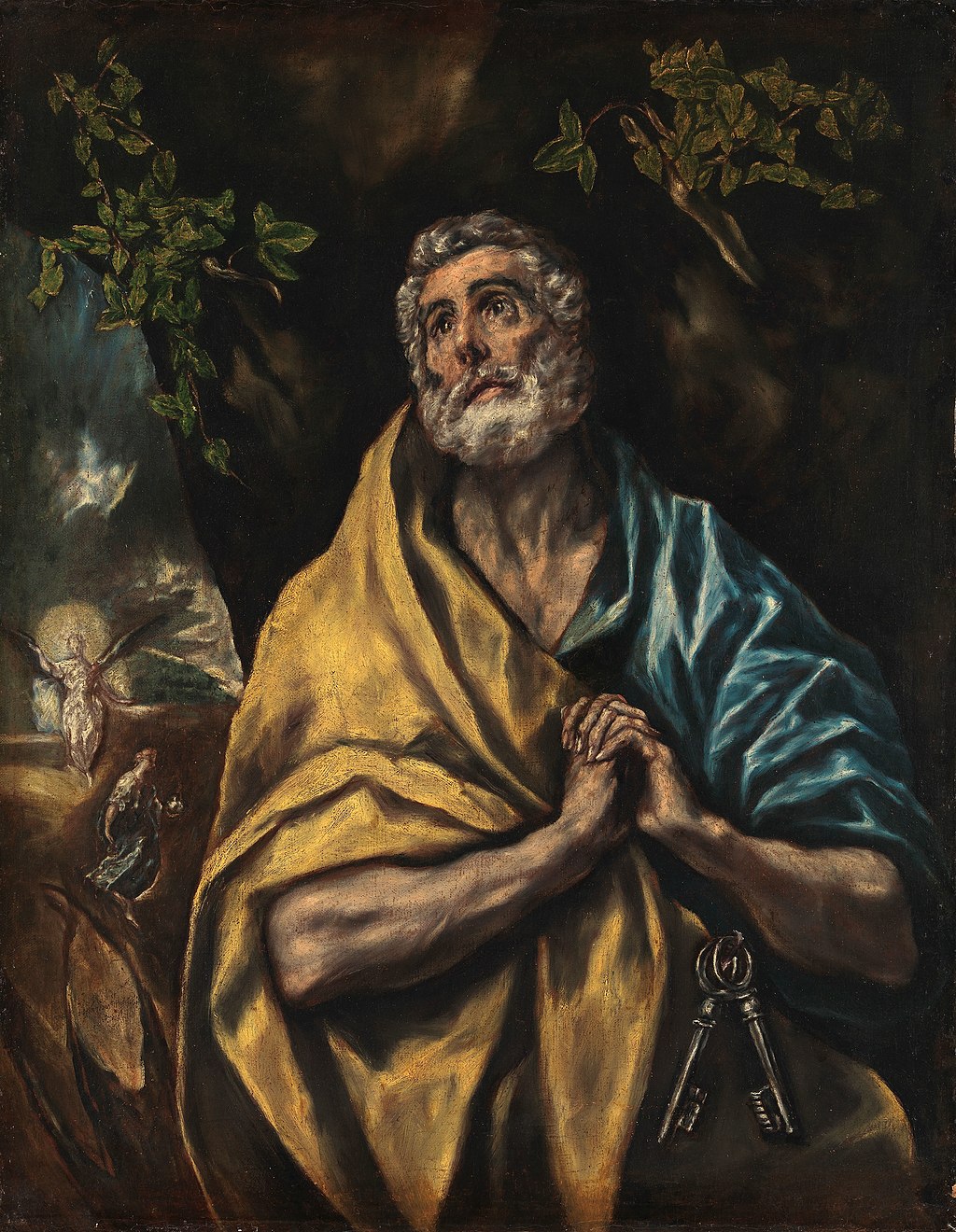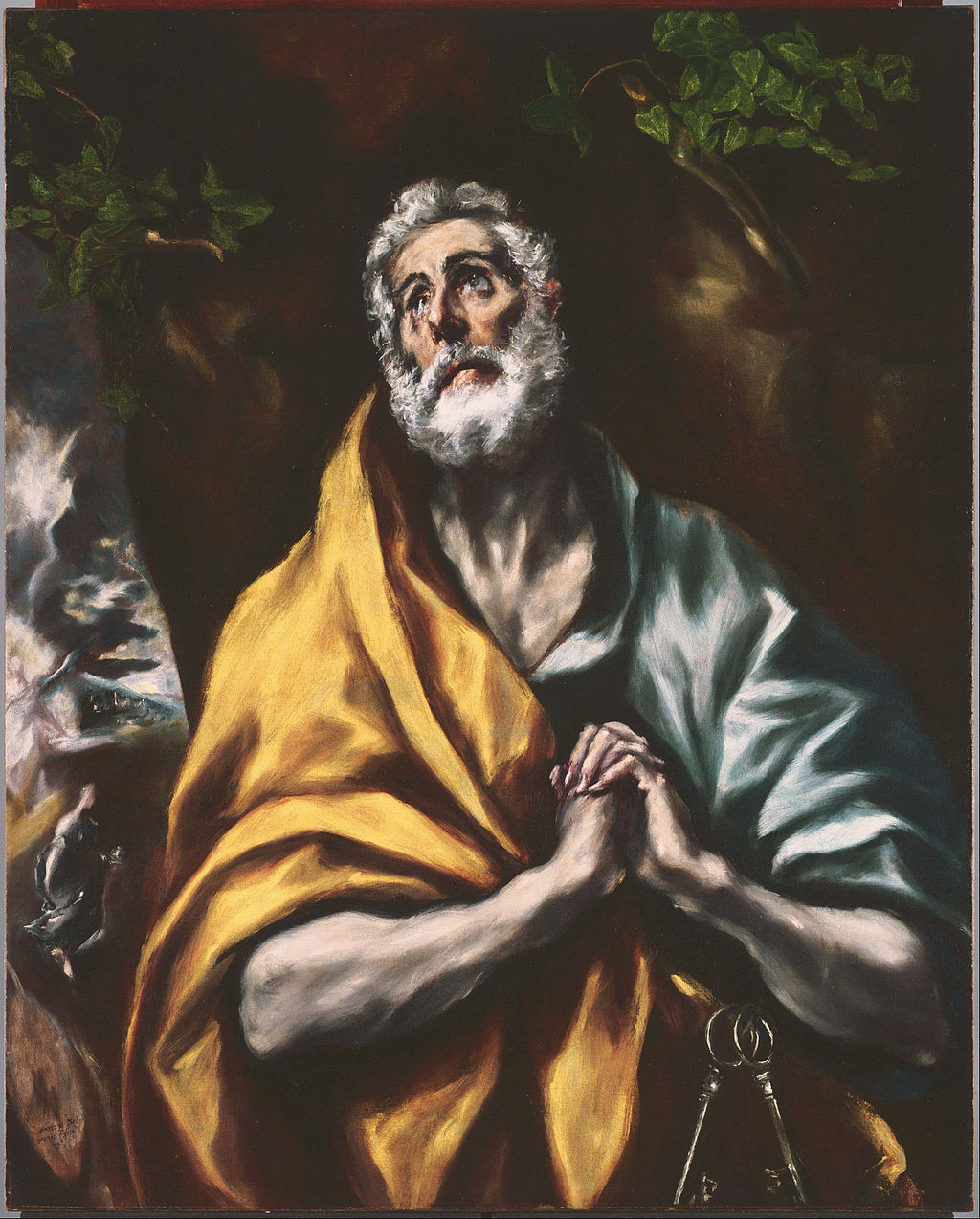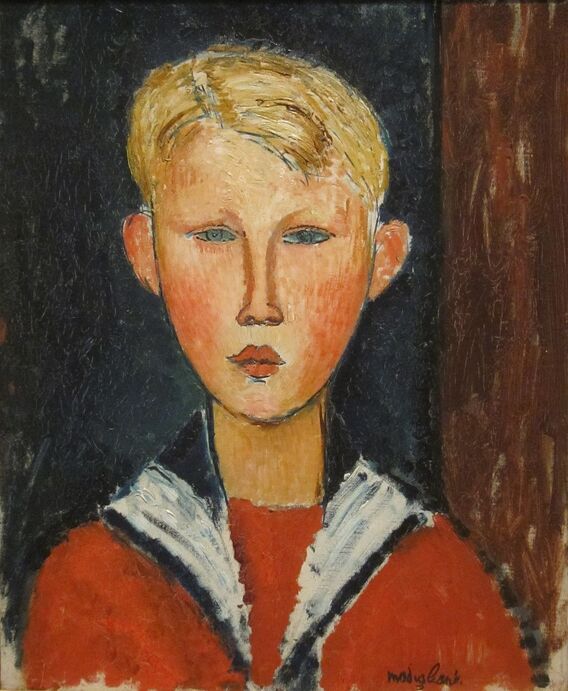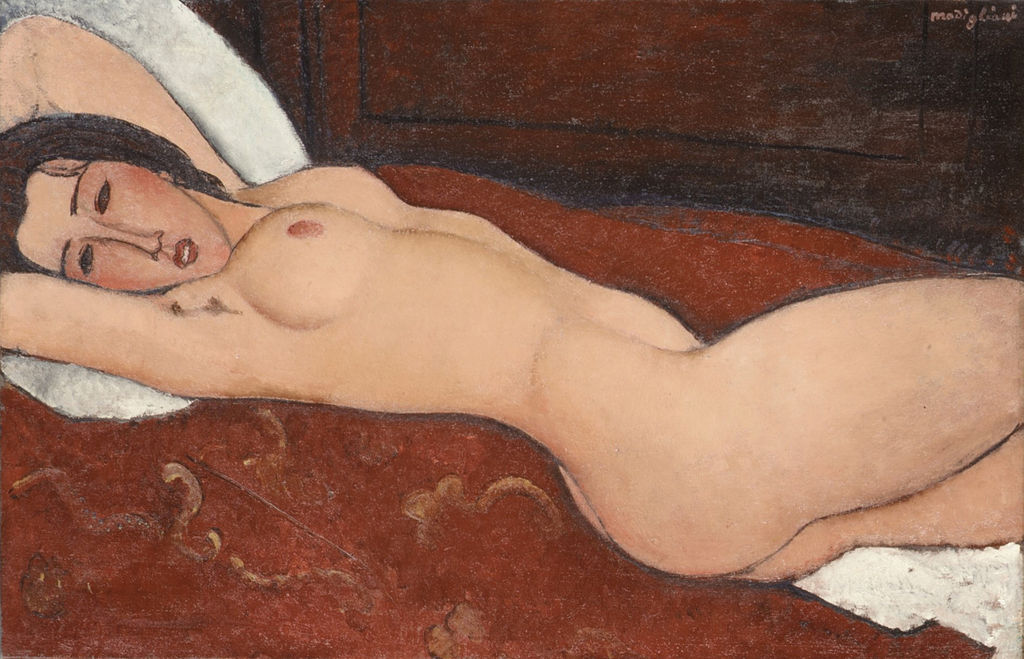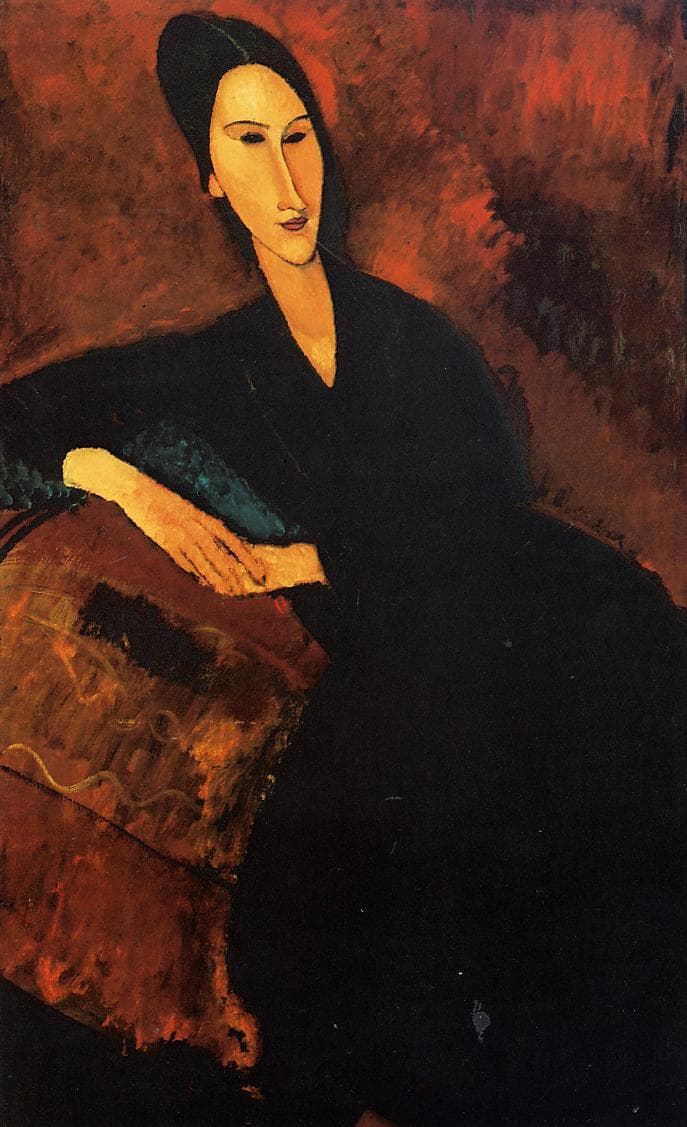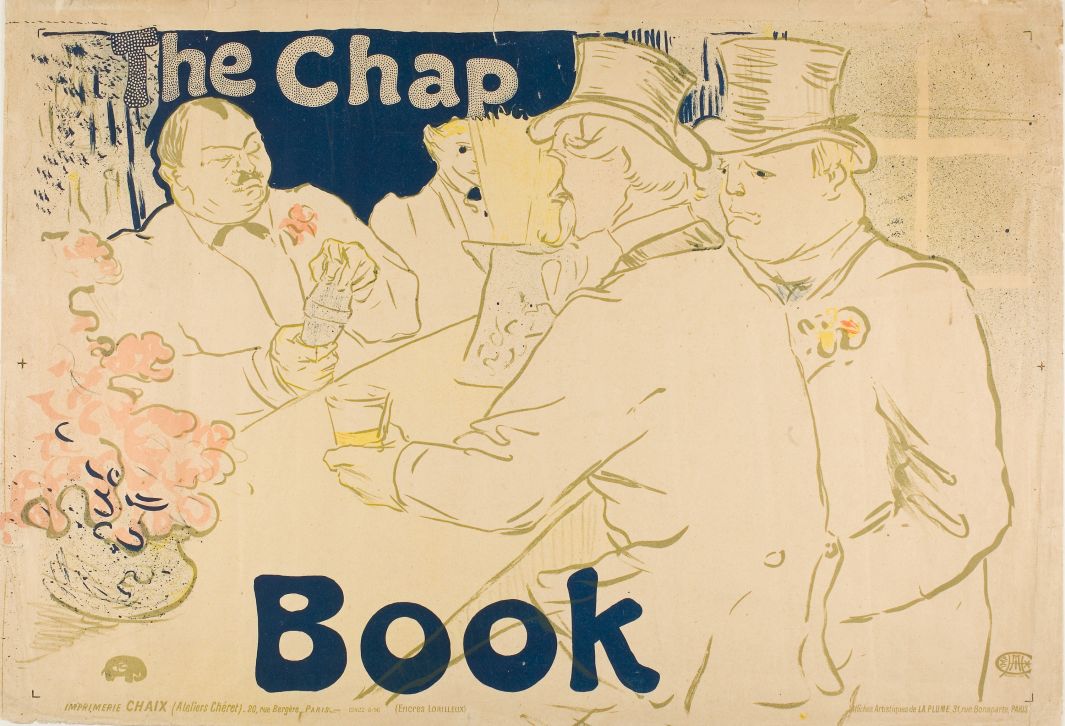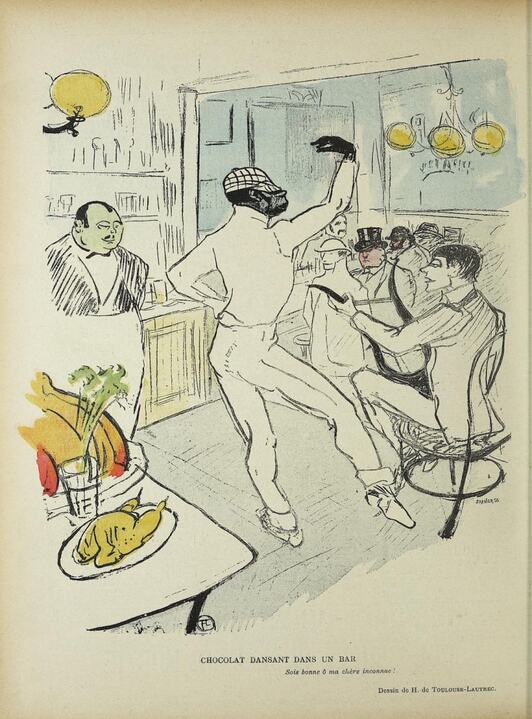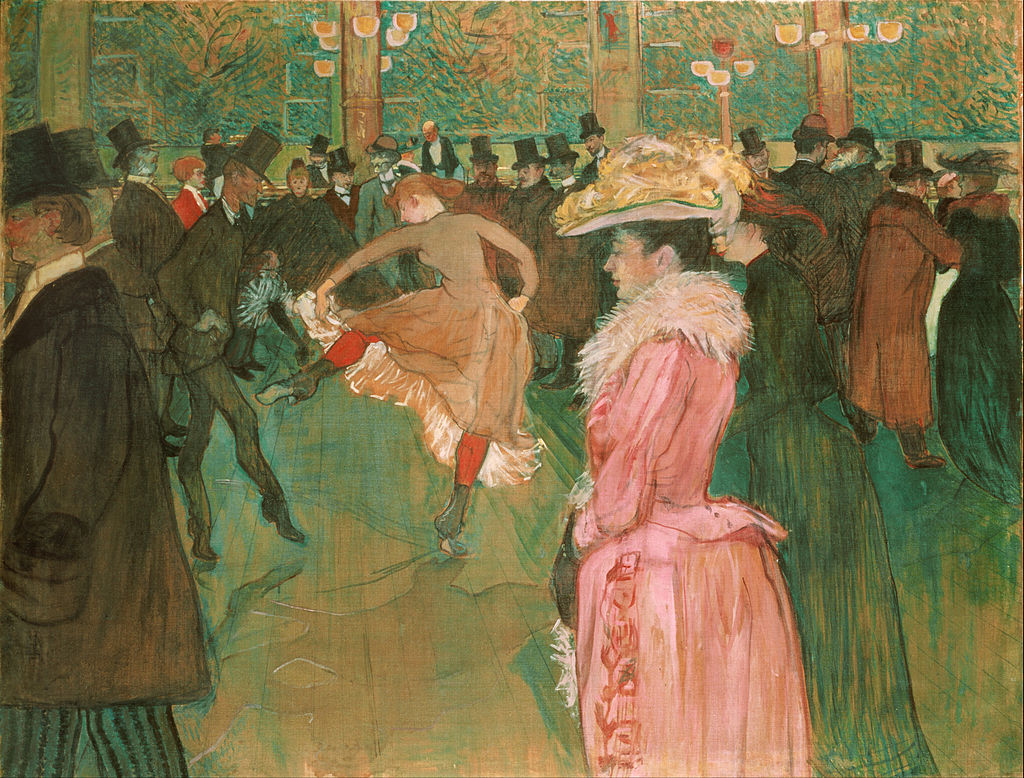|
Where? Room 17 of theSan Diego Museum of Art. A copy of this work is on display in the Statens Museum for Kunst.
When? c. 1636-1638 Commissioned by? King Charles I and Queen Henrietta Maria What do you see? A portrait of Henrietta Maria, the Queen of England. She sits on a chair wearing an elaborate blue satin dress which is decorated with jewelry, including a large brooch at her chest and several pieces of jewelry in the form of a fleur-de-lis (a Catholic symbol especially popular in Henrietta Maria’s birth country of France. She also wears a very expensive pearl necklace, earrings, and a diadem. She had received these pearl jewelry from her mother when she married. In her left hand, the queen has two pink roses. This was her favorite type of flower, and she wanted roses to be included in many of her portraits. On the left, her crown stands on a table. Finally, notice the long pointy fingers of Henrietta Maria, an aesthetic feature considered beautiful during that time. Backstory: Anthony van Dyck painted many portraits of Queen Henrietta Maria. However, the queen did not pose extensively for each of these portraits. Usually, she posed briefly for Van Dyck such that he could draw the outline of her portrait. The queen was then replaced by a stand-in model who would wear the same clothes as the queen. Van Dyck idealized the portrait of the queen. In reality, she was less pretty than she appears on these portraits; she was a short woman, but Van Dyck makes her appear as rather tall. The willingness of Van Dyck to idealize his sitters is one of the reasons that the royal family of England kept coming back to him with more commissions. Who is Queen Henrietta? She was born in 1609 as the daughter of King Henry IV of France. Henrietta Maria of France was 15 years old when she married Charles I who had, months before, become the King of England, Ireland, and Scotland. This made her a queen. She was not very popular in England as she did not master the language well and she was Catholic in a Protestant country. However, she formed a strong bond with King Charles I. Henrietta Maria and Charles I were both art collectors. They commissioned works from some of the leading artists of the day, including Guido Reni, Peter Paul Rubens, and Anthony van Dyck. In 1632, Van Dyck made a family portrait of them which is on display in Windsor Castle.
Other portraits of Queen Henrietta: On August 8, 1632, Charles I commissioned Anthony van Dyck for the first time to paint a portrait of Queen Henrietta Maria. After this first portrait, numerous other portraits of her followed. Most of these portraits were painted by Van Dyck, but for some of them, he got the help of his assistants.
Many of the portraits show Henrietta Maria by herself. For example, in 1638, Van Dyck painted the Portrait of Queen Henrietta Maria in the Hermitage Museum. In some other portraits, she is depicted together with some members of her family or entourage. One example is Queen Henrietta Maria with Sir Jeffrey Hudson in the National Gallery of Art. In total, about 88 portraits of Henrietta Maria are known. These portraits are not only painted by Van Dyck, but also by other painters like Hendrik Gerritsz. Pot and Johannes Vorstermans.
Fun fact: An almost identical portrait of Queen Henrietta Maria of England is owned by the Statens Museum for Kunst in Copenhagen. It is probably of a copy of the version in the San Diego Museum of Art and has been painted by either Van Dyck himself or his workshop.
There are a few differences between both paintings. Most noticeable are the brighter colors in the Copenhagen version which are clearly visible when comparing the dress and the crown in both versions. It also seems as if the version in the San Diego Museum of Art has been cut off on all four sides. Moreover, the Copenhagen version shows a bigger cleavage, earrings on both sides, and a curtain in the background that matches with Henrietta Maria’s dress.
0 Comments
Where? Room 16 of the San Diego Museum of Art
When? c. 1590-1595 Commissioned by? Unknown What do you see? Saint Peter has his hands folded and looks up to the sky. He has just denied his relation with Jesus three times and severely regrets these denials. He had promised Jesus that he would not deny him and now seeks forgiveness for his actions. He is outside in front of a tree, which is a quiet place where he can express his sorrows. We can recognize Saint Peter by several of his attributes. He has his iconic white bushy hair and beard, and he has the Keys of Heaven around his left arm. El Greco also painted Saint Peter with a characteristic golden robe on top of a blue garment. By using luminous colors for these garments and exaggerating certain features, like the long neck, El Greco succeeded in creating a dramatic, eye-catching image of the repentant Saint Peter. Small scene on the left: On the left, next to the large tree, is another scene. It shows Mary Magdalene returning from the grave of Jesus. We can recognize her by the jar of ointment in her left hand. In front of the grave stands a luminous angel. Mary Magdalene has just discovered that the grave of Jesus was empty and hurries away to tell the news that Jesus was resurrected to Saint Peter and the other disciples. Saint Peter’s Denial: This painting is based on the Biblical stories on Saint Peter denying Jesus three times. The stories are described in the Gospels of Matthew 26, Mark 14, Luke 22, John 13, and John 18. During the Last Supper, just before his crucifixion, Jesus told Peter that he would disown Him three times before the rooster would crow. Saint Peter immediately responded to Jesus by saying that he would never deny his relation with Him. But before dawn, Peter did actually deny Jesus three times. Immediately after the third denial, the rooster crowed for the second time, and Peter realized what he had done. He regretted his actions and started to cry as he realized that Jesus was right with his prediction. The denial of Saint Peter and his repentance have inspired various artists over time. Among them is Caravaggio who painted The Denial of Saint Peter in the Metropolitan Museum of Art.
Backstory: The subject of Saint Peter’s repentance was a popular one in the 16th and 17th century in Catholic countries like Italy and Spain. The Catholic Church wanted to promote the idea of repentance to the people. As people, including Saint Peter, naturally makes mistakes, the Church wanted to let people know that they could admit to their sins and ask God for forgiveness.
Restoration: Initially, this painting in the San Diego Museum of Art only showed the main scene on the penitent Saint Peter. But by comparing this work with similar versions (see below) of this work by El Greco, they suspected that there also had to be a smaller scene on the left side of the painting. Indeed, after a thorough cleaning of the painting, the small scene with Mary Magdelene was discovered. Who is El Greco? Doménikos Theotokópoulos, better known as El Greco, was born in 1541 on the Greek island of Crete. During his youth, he learned about the Byzantine Art that was popular in Greece. When he was 27 years old, he moved to Italy and spent several years in cities like Venice and Rome. Here, he became familiar with Renaissance Art and the works of painters like Michelangelo, Tintoretto, and Titian. In 1577, he moved to Toledo, Spain, where he would spend the rest of his life. He combined his early training in Byzantine Art with the things he learned in Italy to create his own unique style. His use of colors and the strongly elongated features of his subjects distinguish his work from any other artist. Among his works are Laocoön in the National Gallery of Art and Saint John the Baptist in the Legion of Honor Museum.
Fun fact: The subject of Saint Peter’s penitence was close to El Greco’s heart. He painted at least six other versions of this subject which are spread across the world. Two versions are in Toledo, Spain, in the El Greco Museum and the Museo Fundación Lerma. Other versions can be found in the Bowes Museum in England, the Museo Soumaya in Mexico City, the National Gallery of Norway, and the Phillips Collection in Washington.
Where? Room 12 of the San Diego Museum of Art
When? 1916 What do you see? A young boy dressed in a red t-shirt and jacket. The middle and inside of his jacket are white and black, but the red color dominates. He has parted his blond hair neatly and stares with his blue eyes at the viewer. But he does not seem to be comfortable. His rosy cheeks and unsettling gaze give the impression that the boy is shy and overwhelmed by the situation in front of him. Modigliani amplified these characteristics of the boy, just like he elongated his nose, neck, and head, and only gave him a small mouth. He used elegant lines for the outline of the boy, but also included asymmetry in many aspects, which is visible in the shape of the boy’s shoulders, face, ears, and hair. Backstory: The painting does not appear more than one hundred years old. The colorful outfit and timeless gaze make it look like this painting is much more recent. The painting is typical for Modigliani in that he simplified the subject in front of him and painted that with pleasant curves and lines on the canvas. The simple but pleasant style of Modigliani does not mean that the end result is always pleasant to look at. The blue-eyed boy, for example, does not look to be carefree and happy. Modigliani may have included some elements into this painting reflecting how he felt when he was a young boy as he had suffered from several serious diseases during his youth. Who is Modigliani? Amedeo Clemente Modigliani was born in 1884 in Livorno in the Northwest of Italy and died in 1920 in Paris. He was draughtsman, painter, and sculptor, but is best known for his paintings. He primarily created portraits and nudes, and these paintings are characterized by strongly elongated features. He painted several pictures of a reclining nude woman, one of which is in the Metropolitan Museum of Art. An example of his many portraits with elongated features is his portrait of Anna Zborowska in the Museum of Modern Art. Modigliani’s works were not positively received during his life but became very popular after his death. In 2015, one of his works – a reclining nude - sold for $170.4 million, making it to the top 10 of most expensive paintings ever sold.
Fun fact: The paintings of Modigliani are a popular target for art forgers. There are three reasons for this.
A striking example of how popular Modigliani’s work is among forgers was a 2017 exhibition of his works in Genoa, Italy. The exhibition was closed early because there was a suspicion that it may contain some forgeries. It turned out that 20 of the 30 works attributed to Modigliani were fake.
Where? Room 10 of the San Diego Museum of Art (fourth drawer of the most-left cabinet)
When? 1895 Commissioned by: The magazine La Plume on behalf of The Chap-Book in Chicago What do you see? An advertisement poster for the American literary magazine The Chap-Book. The scene is the Irish and American Bar in Paris. An anonymous man with a large mustache sits at the bar with a drink. The iconic barman Ralph is preparing a drink for Tom, the driver of the horse-drawn carriage of the Rothschild family, who just arrived. The half-Chinese, half-American-Indian barman was born in San Francisco and known for his special cocktails. Both Ralph and Tom have a floral decoration on their jacket. In the background, another anonymous man stands behind the bar. The bottom of the poster lists, in small print, the printer (Imprimerie Chaix) and the magazine (La Plume) in which this poster is advertised. What is The Chap-Book? The Chap-Book was an American magazine published between 1894 and 1898. Every two weeks, an issue was published containing several short literary stories. An issue cost 5 cents in 1895 and contained, on average, about five short stories. Backstory: The Irish and American Bar was located at the Rue Royale in the center of Paris. The Rue Royale is a short street between the Place de la Concorde and the Place de la Madeleine. The owner of the bar was a Swiss man (Achille) and an Englishman (Reynolds) ran the bar. While Toulouse-Lautrec preferred to hang around in the artistic Montmartre neighborhood of Paris, the Irish and American Bar was among his favorite spots when he wanted to escape Montmartre. When visiting the bar, Toulouse-Lautrec would encounter many other artists. Other people frequenting this place where coachmen who were waiting while their employers would dine in one of the fancy nearby restaurants. Toulouse-Lautrec featured this bar in several posters and drawings, including Chocolat Dancing in the Achille Bar.
Other versions: As Toulouse-Lautrec created the original drawing for this poster on a stone tablet, it could be used to create many prints. Toulouse-Lautrec created two versions of this lithograph. The first version does not have the advertising text, and 100 hundred prints of this version were created for collectors. Some of these prints are now owned by museums like the Museum of Modern Art and the National Gallery of Art.
After the first version was printed on posters, Toulouse-Lautrec added the advertising text and the current poster was printed. Besides the San Diego Museum of Art, prints of this second version are owned by museums like the Art Institute of Chicago. Most museums do not have the lithographs of Toulouse-Lautrec on permanent display as they are sensitive to light exposure. What is Lithography? An image is painted on a smooth metal or stone surface. This surface can subsequently be used to print multiple copies of the original image. Lithographic posters became popular during the end of the 19th century. The recent advances in color printing made it possible to print colored lithographs relatively cheaply. Toulouse-Lautrec was among the artists that picked up lithography. He was able to make good money with these lithographs as the laws on public marketing were relaxed and bars, night clubs, and theaters were now allowed to publicly advertise their business. Who is Toulouse-Lautrec? Henri Marie Raymond de Toulouse-Lautrec-Monfa (1864-1901) came from a French aristocratic family. He suffered from health problems throughout his life and only became 1.42 m (4 ft 8 in) tall. Despite his aristocratic roots, he enjoyed a Bohemian lifestyle in Paris. Even though Toulouse-Lautrec could count on the financial support of his family, he earned his own money as a painter, draughtsman, and illustrator. He was one of the first artists who successfully jumped on the opportunity to create advertising posters. His artistic style was inspired by artists like Degas and Manet. A representative example of his paintings is At the Moulin Rouge: The Dance in the Philadelphia Museum of Art, which he painted in 1890.
Fun fact: Henri de Toulouse-Lautrec loved to spend time in the bar. The Irish and American Bar in this painting was his favorite for some years. He spent so much time there that he invited people that wanted to meet him to the bar. He was typically the last person to leave the bar in the night. He also helped to serve the clients of the bar occasionally. As Toulouse-Lautrec was very short, the owner of the bar had a special platform installed for him such that he could properly serve the clients.
Interested in a copy for yourself? Poster |
Categories
All
|
- Home
- Blog
-
Museums
- Alte Pinakothek
- Art Institute of Chicago
- Baltimore Museum of Art
- Barber Institute of Fine Arts
- Bargello
- Barnes Foundation
- British Museum
- Church of Sant’Anastasia
- Cleveland Museum of Art
- Courtauld Institute of Art
- Detroit Institute of Arts
- Frans Hals Museum
- Galleria Borghese
- Gallerie dell'Accademia
- Getty Museum
- Guggenheim
- Hermitage Museum
- Kunsthistorisches Museum
- Kunstmuseum Basel
- Legion of Honor Museum
- Louvre
- Mauritshuis
- Metropolitan Museum of Art
- Musee d’Orsay
- Museum of Fine Arts in Boston
- Museum of Modern Art
- National Gallery in London
- National Gallery of Art
- National Museum in Poznań
- Norton Simon Museum
- Ny Carlsberg Glyptotek
- Palace of Versailles
- Palazzo Pitti
- Palazzo Vecchio
- Petit Palais
- Philadelphia Museum of Art
- Prado
- Pushkin Museum
- Ravenna Art Museum
- Rijksmuseum
- San Diego Museum of Art
- Santa Maria delle Grazie
- St. Peter's Basilica
- Städel Museum
- Statens Museum for Kunst
- Tate Britain
- Tate Modern
- Timken Museum of Art
- Uffizi
- Vatican Museums
- Wallace Collection
-
Artists
- Altdorfer
- Anguissola
- Berlin Painter
- Bosch
- Botticelli
- Boucher
- Bronzino
- Bruegel the Elder
- Brunelleschi
- Cabanel
- Caillebotte
- Canova
- Caravaggio
- Carpeaux
- Cezanne
- Cimabue
- David
- Degas
- Delacroix
- De Maria
- Donatello
- El Greco
- Fontana
- Fra Angelico
- Fragonard
- Gauguin
- Gentileschi
- Gericault
- Gonzalez-Torres
- Goya
- Hals
- Hogarth
- Hokusai
- Ingres
- Leonardo da Vinci
- Lippi, Filippo
- Longhi, Barbara
- Lorrain
- Makovsky
- Manet
- Massys
- Matisse
- Merian
- Michelangelo
- Mochi
- Modigliani
- Monet
- Panini
- Parmigianino
- Perugino
- Picasso
- Pisanello
- Raphael
- Rembrandt
- Renoir
- Reynolds
- Rivera
- Rodin
- Rubens
- Scultori
- Seurat
- Steen
- Tintoretto
- Titian
- Toulouse-Lautrec
- Turner
- Uccello
- Van der Weyden
- Van Dyck
- Van Eyck
- Van Gogh
- Van Hemessen
- Vasari
- Velazquez
- Vermeer
- Veronese
- Vigée Le Brun
-
Locations
- Books
- About Us

